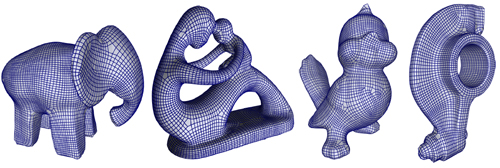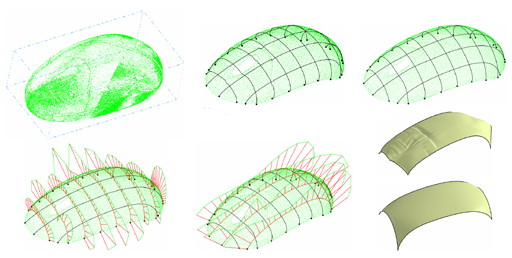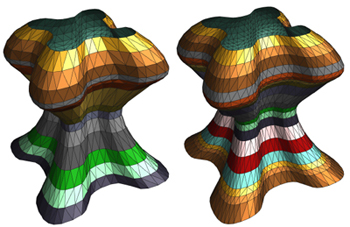|
I have graduated from Dept. of Computer Science and Technology, Tsinghua University, Beijing, China in July, 2008. I'm now a Lecturer at Geometric Computing & Computer Vision, School of Computer Science, Cardiff University, Wales, UK. My new personal homepage: http://users.cs.cf.ac.uk/Yukun.Lai. |
|
Contact Info
Office: S/3.06 Queen's Buildings, 5 The Parade, Roath, Cardiff CF24 3AA, UK.
Tel: +44 (0) 29 20876353
Fax: +44 (0) 29 20874598
Email: Yukun (dot) Lai (at) cs (dot) cardiff (dot) ac (dot) uk
Education
| 09/1999-07/2003 | Dept. of Computer Science and Technology, Tsinghua Univ. | Bachelor Degree | |
| 09/2003-07/2006 | Dept. of Computer Science and Technology, Tsinghua Univ. | Master Degree | |
| 09/2006-07/2008 | Dept. of Computer Science and Technology, Tsinghua Univ. | Ph.D Degree |
Visiting Experience
10/2007-04/2008 Center for Visual Computing, State University of New York at Stony Brook, Stony Brook, NY 11790, USA.
Research Area
- Computer Graphics
- Geometry Processing
- Computer-Aided Geometric Design
- Computer Vision
 |
 |
|
 |
||
 |
 |
Automatic and Topology Preserving Gradient Mesh Generation for Image Vectorization
ACM SIGGRAPH 2009, ACM Transactions on Graphics 28(3), Article No. 85, to appear.

Yu-Kun Lai, Shi-Min Hu and Ralph R. Martin
Gradient mesh vector graphics representation, used in commercial software, is a regular grid with specified position and color, and their gradients, at each grid point. Gradient meshes can compactly represent smoothly changing data, and are typically used for single objects. This paper advances the state of the art for gradient meshes in several significant ways. Firstly, we introduce a topology-preserving gradient mesh representation which allows an arbitrary number of holes. This is important, as objects in images often have holes, either due to occlusion, or their 3D structure. Secondly, our algorithm uses the concept of image manifolds, adapting surface parameterization and fitting techniques to generate the gradient mesh in a fully automatic manner. Existing gradient-mesh algorithms require manual interaction to guide grid construction, and to cut objects with holes into disk-like regions. Our new algorithm is empirically at least 10 times faster than previous approaches. Furthermore, image segmentation can be used with our new algorithm to provide automatic gradient mesh generation for a whole image. Finally, fitting errors can be simply controlled to balance quality with storage.
 |
 |
|
 |
||
 |
 |
Metric Driven RoSy Field Design and Remeshing
IEEE Transactions on Visualization and Computer Graphics (2009) to appear.

Yu-Kun Lai, Miao Jin, Xuexiang Xie, Ying He, Jonathan Palacios, Eugene Zhang, Shi-Min Hu and Xianfeng David Gu
Designing rotational symmetries on surfaces is an important task for a wide range of graphics applications. This work introduces a rigorous and practical algorithm for automatic N-RoSy design on arbitrary surfaces with user defined field topologies. The user has full control of the number, positions and indices of the singularities, the turning numbers of the loops, and is able to edit the field interactively.
 |
 |
|
 |
||
 |
 |
Feature Aligned Quad Dominant Remeshing using Iterative Local Updates
Computer-Aided Design (2009), to appear. 
Yu-Kun Lai, Leif Kobbelt and Shi-Min Hu
Preliminary version appears in Proc. ACM Solid and Physical Modeling 2008.
In this paper we present a new algorithm which turns an unstructured triangle mesh
into a quad-dominant mesh with edges well aligned to the principal directions of
the underlying surface. Instead of computing a globally smooth parameterization
or integrating curvature lines along a tangent vector field, we simply apply an iterative relaxation scheme which incrementally aligns the mesh edges to the principal
directions. We further obtain the quad-dominant mesh by dropping the not-aligned
diagonal edges from the triangle mesh. A post-processing stage is introduced to
further improve the results. The major advantage of our algorithm is its conceptual simplicity since it is merely based on elementary mesh operations such as edge
collapse, flip, and split. The resulting meshes exhibit a very good alignment to surface features and rather uniform distribution of mesh vertices. This makes them
well-suited, e.g., as Catmull-Clark Subdivision control meshes.
 |
 |
|
 |
||
 |
 |
Rapid and Effective Segmentation of 3D Models using Random Walks
Computer Aided Geometric Design (2009) doi:10.1016/j.cagd.2008.09.07, to appear. 
Yu-Kun Lai, Shi-Min Hu, Ralph R. Martin and Paul L. Rosin
Preliminary version appears in Proc. ACM Solid and Physical Modeling 2008.
3D models are now widely available for use in various applications. The demand for automatic model analysis and understanding is ever increasing. Model segmentation is an important step towards model understanding, and acts as a useful tool for different model processing applications, e.g. reverse engineering and modeling by example. We extend a random walk method used previously for image segmentation to give algorithms for both interactive and automatic model segmentation. This method is extremely efficient, and scales almost linearly with the number of faces, and the number of regions. For models of moderate size, interactive performance is achieved with commodity PCs. We demonstrate that this method can be applied to both triangle meshes and point cloud data. It is easy-to-implement, robust to noise in the model, and yields results suitable for downstream applications for both graphical and engineering models.
 |
 |
|
 |
||
 |
 |
Stripification of Free-Form Surfaces with Global Error Bounds for Developable Approximation
IEEE Transactions on Automation Science and Engineering, (2009), doi:10.1109/TASE.2008.2009926, to appear.



Yon-Jin Liu, Yu-Kun Lai and Shi-Min Hu
Developable surfaces have many desired properties in manufacturing process. Since most existing CAD systems utilize tensor-product parametric surfaces including B-splines as design primitives, there is a great demand in industry to convert a general free-form parametric surface within a prescribed global error bound into developable patches. In this work we propose a practical and efficient solution to approximate a rectangular parametric surface with a small set of C^0-joint developable strips. The key contribution of the proposed algorithm is that, several optimization problems are elegantly solved in a sequence that offers a controllable global error bound on the developable surface approximation. Experimental results are presented to demonstrate the effectiveness and stability of the proposed algorithm.
 |
 |
|
 |
||
 |
 |
Fairing Wireframes in Industrial Surface Design
IEEE International Conference on Shape Modeling and Applications, pp. 29-35, 2008.

Yu-Kun Lai, Yong-Jin Liu, Yu Zang and Shi-Min Hu
Wireframe is a modeling tool widely used in industrial geometric design. The term wireframe refers to two sets of curves, with the property that each curve from one set intersects with each curve from the other set. Akin to the u-, v-isocurves in a tensor-product surface, the two sets of curves in a wireframe span an underlying surface. In many industrial design activities, wireframes are usually set up and adjusted by the designers before the whole surfaces are reconstructed. For adjustment, the fairness of wireframe has a direct influence on the quality of the underlying surface. Wireframe fairing is significantly different from fairing individual curves in that intersections should be preserved and kept in the same order. In this paper, we first present a technique for wireframe fairing by fixing the parameters during fairing. The limitation of fixed parameters is further released by an iterative gradient descent optimization method with step-size control. Experimental results show that our solution is efficient, and produces reasonably fairing results of the wireframes.
 |
 |
|
 |
||
 |
 |
Note on Industrial Applications of Hu's Surface Extension Algorithm
Geometric Modeling Processing, pp. 304-314, 2008. 
Zang Yu, Yong-Jin and Yu-Kun Lai
An important surface modeling problem in CAD is to connect two disjoint B-spline patches with the second-order geometric continuity. In this paper we present a study to solve this problem based on the surface extension algorithm [Computer-Aided Design 2002; 34:415--419]. Nice properties of this extension algorithm are exploited in depth and thus make our solution very simple and efficient. Various practical examples are presented to demonstrate the usefulness and efficiency of our presented solution.
 |
 |
|
 |
||
 |
 |
Robust Feature Classification and Editing
IEEE Transactions on Visualization and Computer Graphics, vol. 13, Jan/Feb, pp. 34-45, 2007.

Yu-Kun Lai, Qian-Yi Zhou, Shi-Min Hu, Johannes Wallner and Helmut Pottmann
Sharp edges, ridges, valleys and prongs are critical for the appearance and an accurate representation of a 3D model. In this paper, we propose a novel approach that deals with the global shape of features in a robust way. Based on a remeshing algorithm which delivers an isotropic mesh in a feature sensitive metric, features are recognized on multiple scales via integral invariants of local neighborhoods. Morphological and smoothing operations are then used for feature region extraction and classification into basic types such as ridges, valleys and prongs. The resulting representation of feature regions is further used for feature-specific editing operations.
 |
 |
|
 |
||
 |
 |
Developable Strip Approximation of Parametric Surfaces with Global Error Bounds
Pacific Graphics, pp. 441-444, 2007(poster).

Yong-Jin Liu, Yu-Kun Lai and Shi-Min Hu
Developable surfaces have many desired properties in manufacturing process. Since most existing CAD systems utilize parametric surfaces as the design primitive, there is a great demand in industry to convert a parametric surface within a prescribed global error bound into developable patches. In this work we propose a simple and efficient solution to approximate a general parametric surface with a minimum set of $C^0$-joint developable strips. The key contribution of the proposed algorithm is that, several global optimization problems are elegantly solved in a sequence that offers a controllable global error bound on the developable surface approximation. Experimental results are presented to demonstrate the effectiveness and stability of the proposed algorithm.
 |
 |
|
 |
||
 |
 |
Principal curvatures from the integral invariant viewpoint
Computer Aided Geometric Design, vol. 24, pp. 428-442, 2007.

Helmut Pottmann, Johannes Wallner, Yong-Liang Yang, Yu-Kun Lai and Shi-Min Hu
The extraction of curvature information for surfaces is a basic problem of Geometry Processing. Recently an integral invariant solution of this problem was presented, which is based on principal component analysis of local neighbourhoods defined by kernel balls of various sizes. It is not only robust to noise, but also adjusts to the level of detail required. In the present paper we show an asymptotic analysis of the moments of inertia and the principal directions which are used in this approach. We also address implementation and, briefly, robustness issues and applications.
 |
 |
|
 |
||
 |
 |
Surface Fitting Based on a Feature Sensitive Parameterization
Computer-Aided Design, Vol. 38, No. 7, pp. 800-807, 2006.

Yu-Kun Lai, Shi-Min Hu and Helmut Pottmann
Most approaches to least squares fitting of a B-spline surface to measurement data require a parametrization of the data point set and the choice of suitable knot vectors. We propose to use uniform knots in connection with a feature sensitive parametrization. This parametrization allocates more parameter space to highly curved feature regions and thus automatically provides more control points where they are needed.
 |
 |
|
 |
||
 |
 |
Surface Mosaics
The Visual Computer, vol. 22, no. 9-11, pp. 604-611, 2006 (Special issues of Pacific Graphics).

Yu-Kun Lai, Shi-Min Hu and Ralph R. Martin
This paper considers the problem of placing mosaic tiles on a surface to produce a surface mosaic. We assume that the user specifies a mesh model, the size of the tiles and the amount of grout, and optionally, a few control vectors at key locations on the surface indicating the preferred tile orientation at these points. From these inputs, we place equal-sized rectangular tiles over the mesh such as to almost cover it, with controlled orientation. The alignment of the tiles follows a vector field which is interpolated over the surface from the control vectors, and also forced into alignment with any sharp creases, open boundaries, and boundaries between regions of different colors. Our method efficiently solves the problem by posing it as one of globally optimizing a spring-like energy in the Manhattan metric, using overlapping local parameterizations.We demonstrate the effectiveness of our algorithm with various examples.
 |
 |
|
 |
||
 |
 |
Feature Sensitive Mesh Segmentation
ACM Symposium on Solid and Physical Modeling, pp. 7-16, 2006.

Yu-Kun Lai, Shi-Min Hu and Ralph R. Martin
This paper considers the problem of placing mosaic tiles on a surface to produce a surface mosaic. We assume that the user specifies a mesh model, the size of the tiles and the amount of grout, and optionally, a few control vectors at key locations on the surface indicating the preferred tile orientation at these points. From these inputs, we place equal-sized rectangular tiles over the mesh such as to almost cover it, with controlled orientation. The alignment of the tiles follows a vector field which is interpolated over the surface from the control vectors, and also forced into alignment with any sharp creases, open boundaries, and boundaries between regions of different colors. Our method efficiently solves the problem by posing it as one of globally optimizing a spring-like energy in the Manhattan metric, using overlapping local parameterizations.We demonstrate the effectiveness of our algorithm with various examples.
 |
 |
|
 |
||
 |
 |
Robust Principal Curvatures on Multiple Scales
Eurographics Symposium on Geometry Processing, pp. 223-226, 2006. 
Yong-Liang Yang, Yu-Kun Lai, Shi-Min Hu and Helmut Pottmann
Geometry processing algorithms often require the robust extraction of curvature information. We propose to achieve this with principal component analysis (PCA) of local neighborhoods, defined via spherical kernels centered on the given surface F. Intersection of a kernel ball Br or its boundary sphere Sr with the volume bounded by F leads to the so-called ball and sphere neighborhoods. Information obtained by PCA of these neighborhoods turns out to be more robust than PCA of the patch neighborhood Br \F previously used. The relation of the quantities computed by PCA with the principal curvatures of F is revealed by an asymptotic analysis as the kernel radius r tends to zero. This also allows us to define principal curvatures “at scale r” in a way which is consistent with the classical setting. The advantages of the new approach are discussed in a comparison with results obtained by normal cycles and local fitting; whereas the former method somewhat lacks in robustness, the latter does not achieve a consistent behavior at features on coarse scales. As to applications, we address computing principal curves and feature extraction on multiple scales.
 |
 |
|
 |
||
 |
 |
Geometric texture synthesis and transfer via geometry images
ACM Symposium on Solid and Physical Modeling, pp. 15-26, 2005.

Yu-Kun Lai, Shi-Min Hu, Xianfeng Gu and Ralph R. Martin
In this paper, we present an automatic method which can transfer geometric textures from one object to another, and can apply a manually designed geometric texture to a model. Our method is based on geometry images as introduced by Gu et al. The key ideas in this method involve geometric texture extraction, boundary consistent texture synthesis, discretized orientation and scaling, and reconstruction of synthesized geometry. Compared to other methods, our approach is efficient and easy-to-implement, and produces results of high quality.
Prizes and Honors Top
Scholarships
- Microsoft Fellowship, 2007.
- First-Class Scholarship of Excellent Students in Tsinghua Univ. (Morgan Stanley Scholarship), 2006.
- First-Class Scholarship of Excellent Students in Tsinghua Univ. (Sony Scholarship), 2002.
- Second-Class Scholarship of Excellent Students in Tsinghua Univ., 2001.
Prizes in Contests
- Second Prize in Intel Cup Undergraduate Electronic Design Contest (Embedded System Design Invitational Contest), 2002, with Haohuan Fu and Tianling Zhou.
- Second Prize in China Undergraduate Mathematical Contest in Modeling, 2001, with Qi Zhu and Fangfang Xia.
- Gold Medal in National Olympiad in Informatics (NOI) of China, 1998.
Honors
- Excellent PhD Graduate, Dept. of Computer Science and Technology, Tsinghua University, 2008.
- First-Class Excellent Doctoral Thesis, Tsinghua University, 2008.
- Outstanding Young Researcher, Dept. of Computer Science and Technology, Tsinghua University, 2006.
- Excellet Graduate of Tsinghua University, 2003.
- Excellent Bachelor Thesis, Tsinghua University, 2003.
